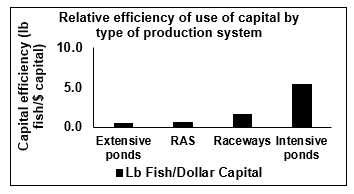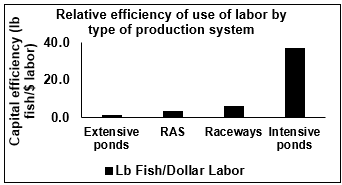COST DRIVERS AND PROFITABILITY OF U.S. POND, RACEWAY, AND RAS AQUACULTURE
U.S. aquaculture has grown at a slower rate than the rest of the world in spite of abundant resources to support its growth. There has not been a comprehensive attempt to examine cost structures, productivity, and associated efficiencies across species, production systems, and scales. Comprehensive enterprise budgets (58) were developed for various management strategies/scales of production for catfish, baitfish/sportfish, and largemouth bass foodfish in ponds, trout production in raceways, and recirculating aquaculture system (RAS) production of Atlantic salmon, trout, and tilapia in the U.S. Results showed long-term profitability only for pond production of catfish, trout, largemouth bass, and baitfish/sportfish. None of the RAS showed profits, but larger-scale RAS showed fewer losses (in $/kg of fish produced) than smaller-scale RAS. Economies of scale were found for all species/systems analyzed. Feed, capital, labor, management, energy, and fingerling costs (in some scenarios) were identified as the major factors contributing to overall costs of production, but the order of importance varied with the species/system/scale. For those species/systems for which variable costs tended to be the greatest type of costs, improvements in feed conversion ratio and labor productivity (kg of fish produced per $ of annual labor cost) have the greatest potential to reduce per-unit costs of production. For RAS, improving productivity of both labor and capital (in terms of kg of fish produced per $ of annualized capital costs) may be as important as production scale to achieve profitability. Labor and capital use productivity were much greater on the well-established and generally profitable catfish and trout businesses than in the RAS scenarios analyzed. Results should be of value to lenders, investors, those who make decisions on research funding priorities, and policy-makers.

